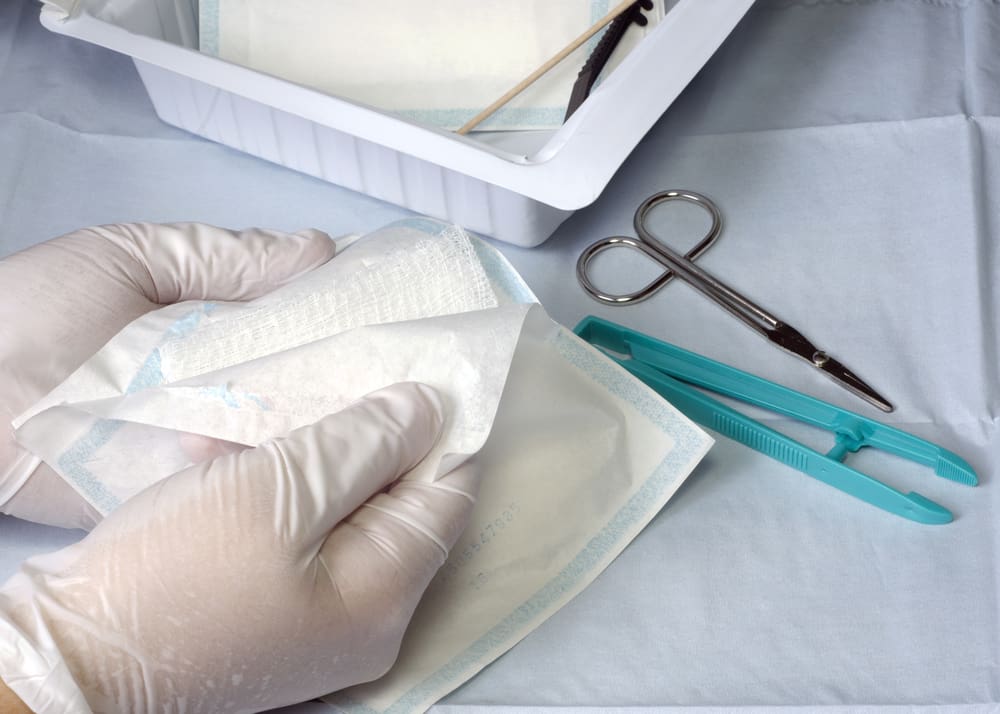Detect and report warning signs to save lives.
Takeaways:
- Dehiscence of abdominal surgical wounds is a medical emergency and requires immediate action to reduce further complications.
- Knowing who is at risk and the early signs of dehiscence can help you take measures quickly.
- Prevention of dehiscence by minimizing closure disruption and enhancing wound healing is key.
Wound care: Five evidence-based practices
Moisture-associated skin damage: The basics
John Anderson* is a 72-year-old patient with colorectal cancer, hypoalbuminemia (an indication of poor nutrition), and type 2 diabetes who was admitted to the medical-surgical unit after an open colon resection 4 days ago. His nasogastric tube was removed 2 hours ago.
When you respond to Mr. Anderson’s call light, you observe that he’s distressed and that his hands are clasped over his abdomen. He states that “something gave way” while coughing and that he’s experiencing significant abdominal pain. Your assessment reveals that Mr. Anderson’s abdominal surgical incision has partially separated down to the fascia, with only a few of the staples still intact. You see a large amount of serosanguineous exudate in and around the wound, but no signs of redness, swelling, warmth, or foul odor.
Although no evisceration has occurred, you recognize Mr. Anderson’s wound dehiscence as a rare but severe complication of abdominal surgery and immediately request the unit secretary to contact the patient’s surgeon. You reassure Mr. Anderson that the surgeon will be in to see him soon.
*Names are fictitious.
On the scene
To decrease intra-abdominal pressure and stress on the wound, you place Mr. Anderson supine in the low Fowler’s position with his knees slightly bent and cover the wound with a saline-moistened, sterile gauze dressing. His vital signs are normal except for a heart rate of 102 beats per minute. Mr. Anderson rates his pain at 8 out of 10. His I.V. line is patent. To help control the patient’s pain, you administer his as-needed I.V. opioid and withhold all oral intake in case the surgeon recommends surgery.
When the surgeon arrives, he orders an abdominal binder to help prevent evisceration. After discussing treatment options with the patient, the surgeon orders negative pressure wound therapy (NPWT) due to Mr. Anderson’s chronic health conditions and increased risk of dehiscence recurrence. NPWT will provide secondary closure and enhance healing by pulling exudate and bacteria from the site while keeping the wound bed moist.
Outcome
Mr. Anderson requires a longer hospital stay to ensure that wound granulation occurs with NPWT and to manage his pain. Wound healing through secondary intention increases his risk for further complications, such as infection or incisional herniation. After 7 days, Mr. Anderson is discharged with home health for continued wound care.
Education
To prevent dehiscence, teach patients to splint the surgical site when coughing, vomiting, or sneezing. An abdominal binder for those at risk for dehiscence may be helpful, but evidence supporting its use is still needed. Heavy lifting (10 lbs or more) should be avoided for 6 to 8 weeks after surgery. Additional teaching topics to enhance wound healing include incisional care, blood glucose control, increased dietary protein, and the use of stool softeners to prevent straining caused by constipation.
Although dehiscence occurs in less than 3% of abdominal surgeries, it’s associated with a mortality of 14% to 50%, with evisceration increasing the risk of death. Conditions that increase intra-abdominal pressure (obesity) or may disrupt skin health (poor nutrition, steroid use, diabetes) place patients at increased risk of dehiscence. After surgery, closure disruption from increased pressure due to an ileus, distention, coughing, broken sutures, or infection also increases patients’ risk. Inspect the skin for signs of impending dehiscence, such as localized bruising, pain, lack of a healing ridge by postoperative days 5 to 9, and nausea/vomiting. Early detection could save your patient’s life.
Wendy R. Downey is an assistant professor at Radford University School of Nursing in Radford, Virginia.
References
Aksamija G, Mulabdic A, Rasic I, Aksamija L. Evaluation of risk factors of surgical wound dehiscence in adults after laparotomy. Med Arch. 2016;70(5):369-72.
Doughty DB, McNichol LL. Wound, Ostomy and Continence Nurses Society® Core Curriculum: Wound Management. Philadelphia, PA: Wolters Kluwer; 2016.



















2 Comments.
I felt a separation, from my midline to my sides, lateral
I believe the mesh put in, because of my Hernia repair has shifted upward into my right sternum and right lateral area.
CT SCAN states there is a dehiscence rectus abdominis muscles. Tiny umbilical hernia contains fat. Possible Faty Liver. I strongly believe the mesh is in the Liver area.
Have an abdominal wound that still not healing despite few attempts at surgery and vacuum dressings. Anyone else in same situation?